Analyzing Housing Market Dynamics in Sydney & Melbourne, Australia
VerifiedAdded on 2023/06/12
|10
|2208
|297
Report
AI Summary
This report analyzes the housing crisis in Sydney and Melbourne, Australia, from a business economics perspective. It identifies the key factors contributing to rising housing prices, including increased demand from domestic and immigrant populations, low interest rates, and constrained housing supply due to planning restrictions. The report highlights the mismatch between housing demand and supply, leading to affordability issues, particularly for renters and first home-buyers. It also discusses the impact of migration and household age distribution on the housing market. The report suggests policy recommendations, such as controlling migration and easing planning restrictions, to address the housing affordability crisis and prevent the formation of a housing bubble. It further contrasts the buying and renting affordability in both cities, concluding that renting is a more economically feasible option for young professionals due to high housing prices.
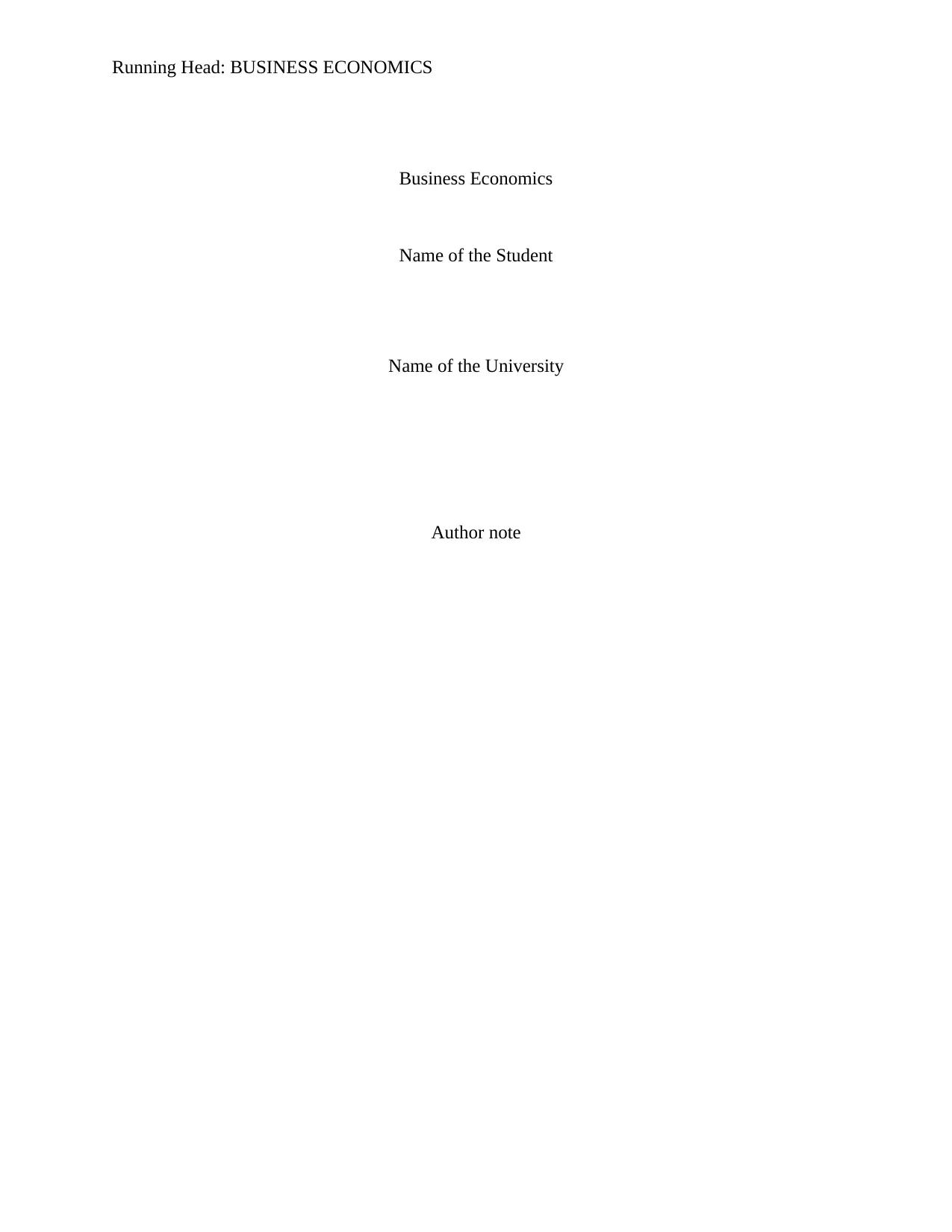
Running Head: BUSINESS ECONOMICS
Business Economics
Name of the Student
Name of the University
Author note
Business Economics
Name of the Student
Name of the University
Author note
Paraphrase This Document
Need a fresh take? Get an instant paraphrase of this document with our AI Paraphraser
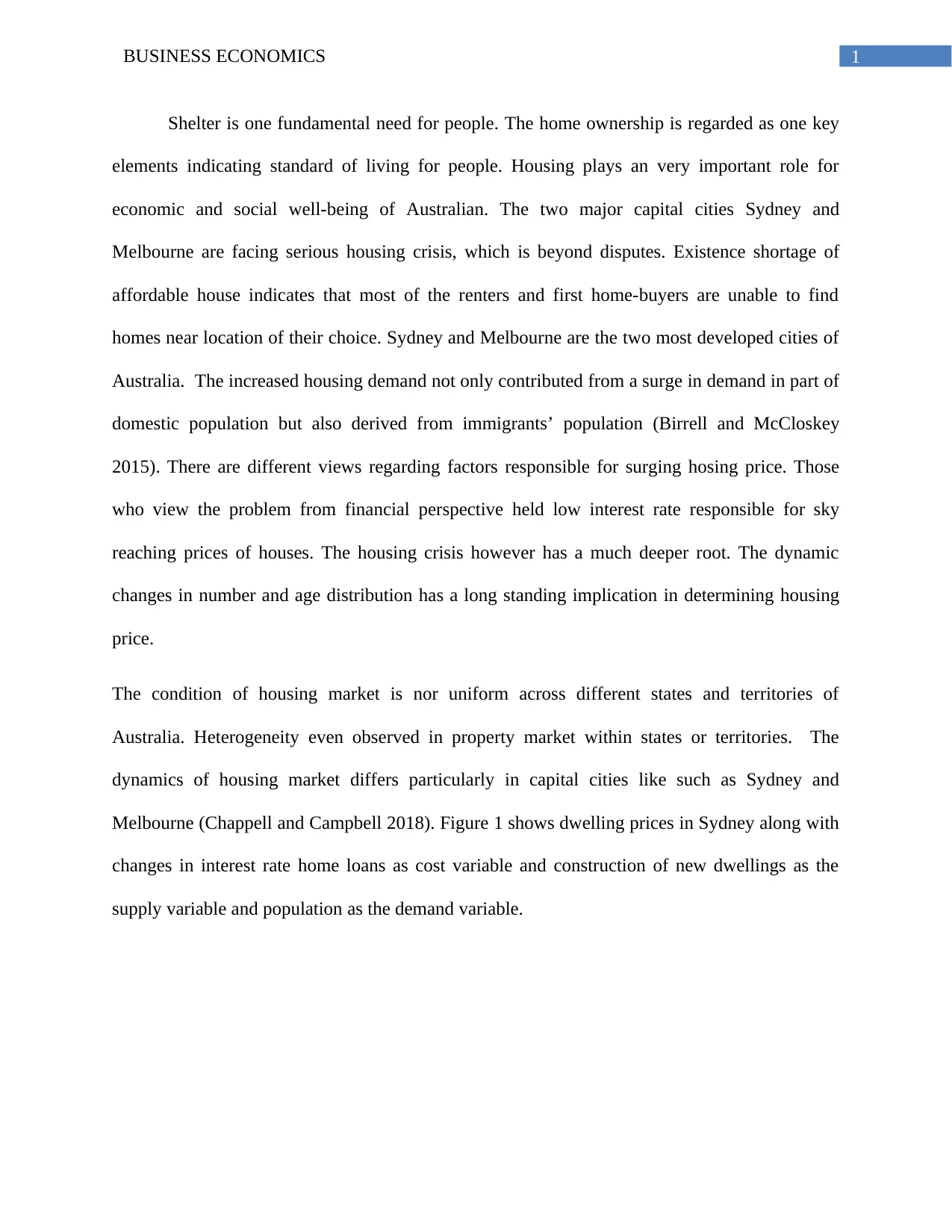
1BUSINESS ECONOMICS
Shelter is one fundamental need for people. The home ownership is regarded as one key
elements indicating standard of living for people. Housing plays an very important role for
economic and social well-being of Australian. The two major capital cities Sydney and
Melbourne are facing serious housing crisis, which is beyond disputes. Existence shortage of
affordable house indicates that most of the renters and first home-buyers are unable to find
homes near location of their choice. Sydney and Melbourne are the two most developed cities of
Australia. The increased housing demand not only contributed from a surge in demand in part of
domestic population but also derived from immigrants’ population (Birrell and McCloskey
2015). There are different views regarding factors responsible for surging hosing price. Those
who view the problem from financial perspective held low interest rate responsible for sky
reaching prices of houses. The housing crisis however has a much deeper root. The dynamic
changes in number and age distribution has a long standing implication in determining housing
price.
The condition of housing market is nor uniform across different states and territories of
Australia. Heterogeneity even observed in property market within states or territories. The
dynamics of housing market differs particularly in capital cities like such as Sydney and
Melbourne (Chappell and Campbell 2018). Figure 1 shows dwelling prices in Sydney along with
changes in interest rate home loans as cost variable and construction of new dwellings as the
supply variable and population as the demand variable.
Shelter is one fundamental need for people. The home ownership is regarded as one key
elements indicating standard of living for people. Housing plays an very important role for
economic and social well-being of Australian. The two major capital cities Sydney and
Melbourne are facing serious housing crisis, which is beyond disputes. Existence shortage of
affordable house indicates that most of the renters and first home-buyers are unable to find
homes near location of their choice. Sydney and Melbourne are the two most developed cities of
Australia. The increased housing demand not only contributed from a surge in demand in part of
domestic population but also derived from immigrants’ population (Birrell and McCloskey
2015). There are different views regarding factors responsible for surging hosing price. Those
who view the problem from financial perspective held low interest rate responsible for sky
reaching prices of houses. The housing crisis however has a much deeper root. The dynamic
changes in number and age distribution has a long standing implication in determining housing
price.
The condition of housing market is nor uniform across different states and territories of
Australia. Heterogeneity even observed in property market within states or territories. The
dynamics of housing market differs particularly in capital cities like such as Sydney and
Melbourne (Chappell and Campbell 2018). Figure 1 shows dwelling prices in Sydney along with
changes in interest rate home loans as cost variable and construction of new dwellings as the
supply variable and population as the demand variable.
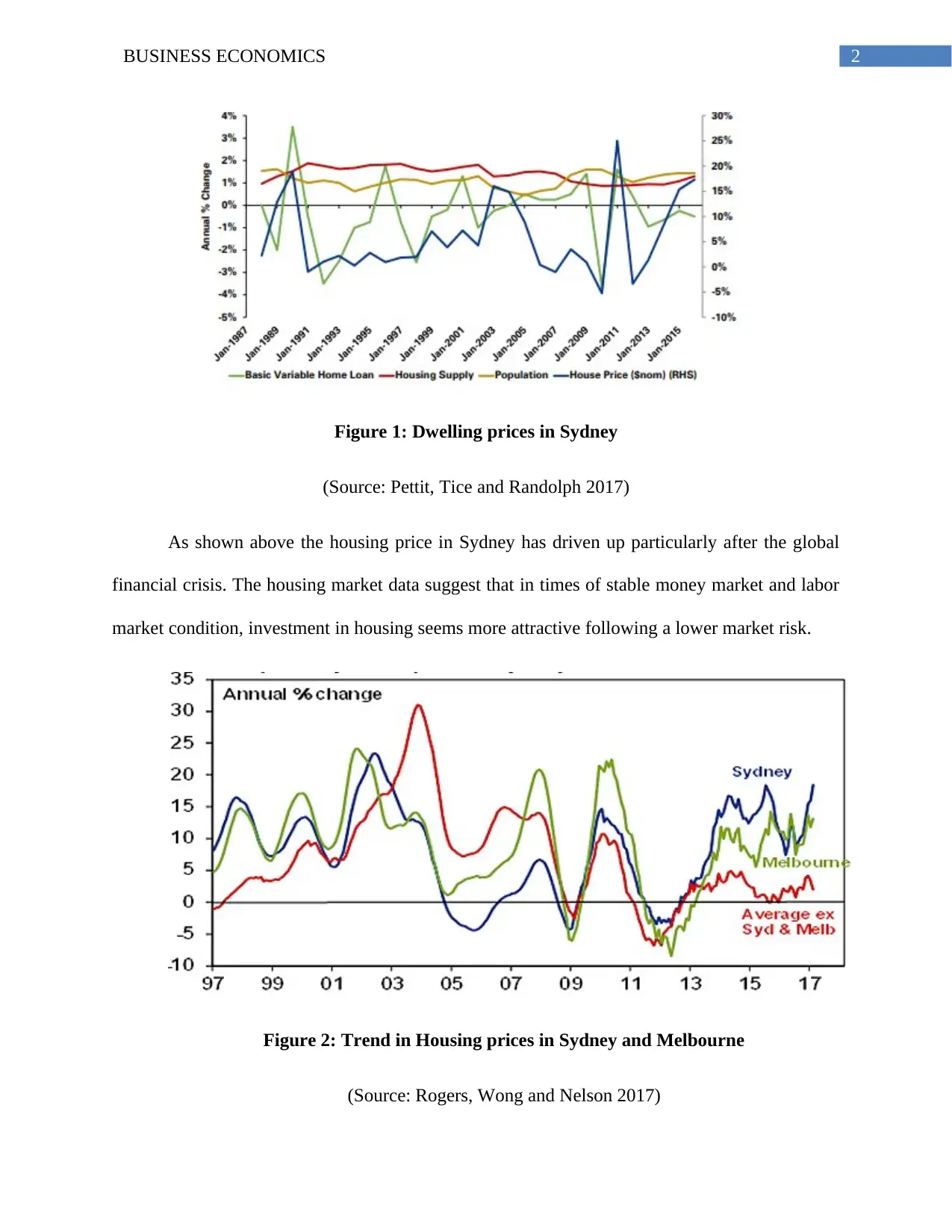
2BUSINESS ECONOMICS
Figure 1: Dwelling prices in Sydney
(Source: Pettit, Tice and Randolph 2017)
As shown above the housing price in Sydney has driven up particularly after the global
financial crisis. The housing market data suggest that in times of stable money market and labor
market condition, investment in housing seems more attractive following a lower market risk.
Figure 2: Trend in Housing prices in Sydney and Melbourne
(Source: Rogers, Wong and Nelson 2017)
Figure 1: Dwelling prices in Sydney
(Source: Pettit, Tice and Randolph 2017)
As shown above the housing price in Sydney has driven up particularly after the global
financial crisis. The housing market data suggest that in times of stable money market and labor
market condition, investment in housing seems more attractive following a lower market risk.
Figure 2: Trend in Housing prices in Sydney and Melbourne
(Source: Rogers, Wong and Nelson 2017)
⊘ This is a preview!⊘
Do you want full access?
Subscribe today to unlock all pages.

Trusted by 1+ million students worldwide
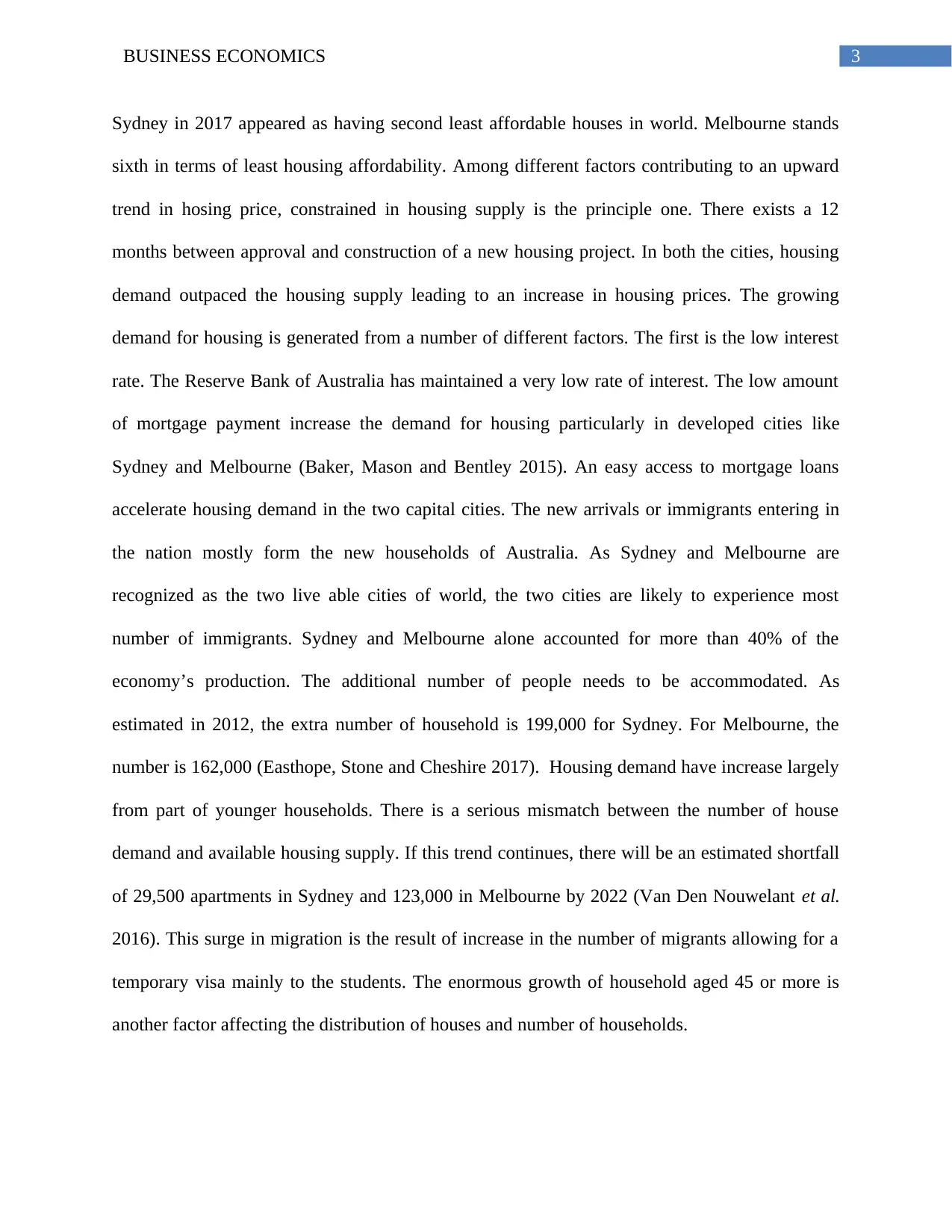
3BUSINESS ECONOMICS
Sydney in 2017 appeared as having second least affordable houses in world. Melbourne stands
sixth in terms of least housing affordability. Among different factors contributing to an upward
trend in hosing price, constrained in housing supply is the principle one. There exists a 12
months between approval and construction of a new housing project. In both the cities, housing
demand outpaced the housing supply leading to an increase in housing prices. The growing
demand for housing is generated from a number of different factors. The first is the low interest
rate. The Reserve Bank of Australia has maintained a very low rate of interest. The low amount
of mortgage payment increase the demand for housing particularly in developed cities like
Sydney and Melbourne (Baker, Mason and Bentley 2015). An easy access to mortgage loans
accelerate housing demand in the two capital cities. The new arrivals or immigrants entering in
the nation mostly form the new households of Australia. As Sydney and Melbourne are
recognized as the two live able cities of world, the two cities are likely to experience most
number of immigrants. Sydney and Melbourne alone accounted for more than 40% of the
economy’s production. The additional number of people needs to be accommodated. As
estimated in 2012, the extra number of household is 199,000 for Sydney. For Melbourne, the
number is 162,000 (Easthope, Stone and Cheshire 2017). Housing demand have increase largely
from part of younger households. There is a serious mismatch between the number of house
demand and available housing supply. If this trend continues, there will be an estimated shortfall
of 29,500 apartments in Sydney and 123,000 in Melbourne by 2022 (Van Den Nouwelant et al.
2016). This surge in migration is the result of increase in the number of migrants allowing for a
temporary visa mainly to the students. The enormous growth of household aged 45 or more is
another factor affecting the distribution of houses and number of households.
Sydney in 2017 appeared as having second least affordable houses in world. Melbourne stands
sixth in terms of least housing affordability. Among different factors contributing to an upward
trend in hosing price, constrained in housing supply is the principle one. There exists a 12
months between approval and construction of a new housing project. In both the cities, housing
demand outpaced the housing supply leading to an increase in housing prices. The growing
demand for housing is generated from a number of different factors. The first is the low interest
rate. The Reserve Bank of Australia has maintained a very low rate of interest. The low amount
of mortgage payment increase the demand for housing particularly in developed cities like
Sydney and Melbourne (Baker, Mason and Bentley 2015). An easy access to mortgage loans
accelerate housing demand in the two capital cities. The new arrivals or immigrants entering in
the nation mostly form the new households of Australia. As Sydney and Melbourne are
recognized as the two live able cities of world, the two cities are likely to experience most
number of immigrants. Sydney and Melbourne alone accounted for more than 40% of the
economy’s production. The additional number of people needs to be accommodated. As
estimated in 2012, the extra number of household is 199,000 for Sydney. For Melbourne, the
number is 162,000 (Easthope, Stone and Cheshire 2017). Housing demand have increase largely
from part of younger households. There is a serious mismatch between the number of house
demand and available housing supply. If this trend continues, there will be an estimated shortfall
of 29,500 apartments in Sydney and 123,000 in Melbourne by 2022 (Van Den Nouwelant et al.
2016). This surge in migration is the result of increase in the number of migrants allowing for a
temporary visa mainly to the students. The enormous growth of household aged 45 or more is
another factor affecting the distribution of houses and number of households.
Paraphrase This Document
Need a fresh take? Get an instant paraphrase of this document with our AI Paraphraser
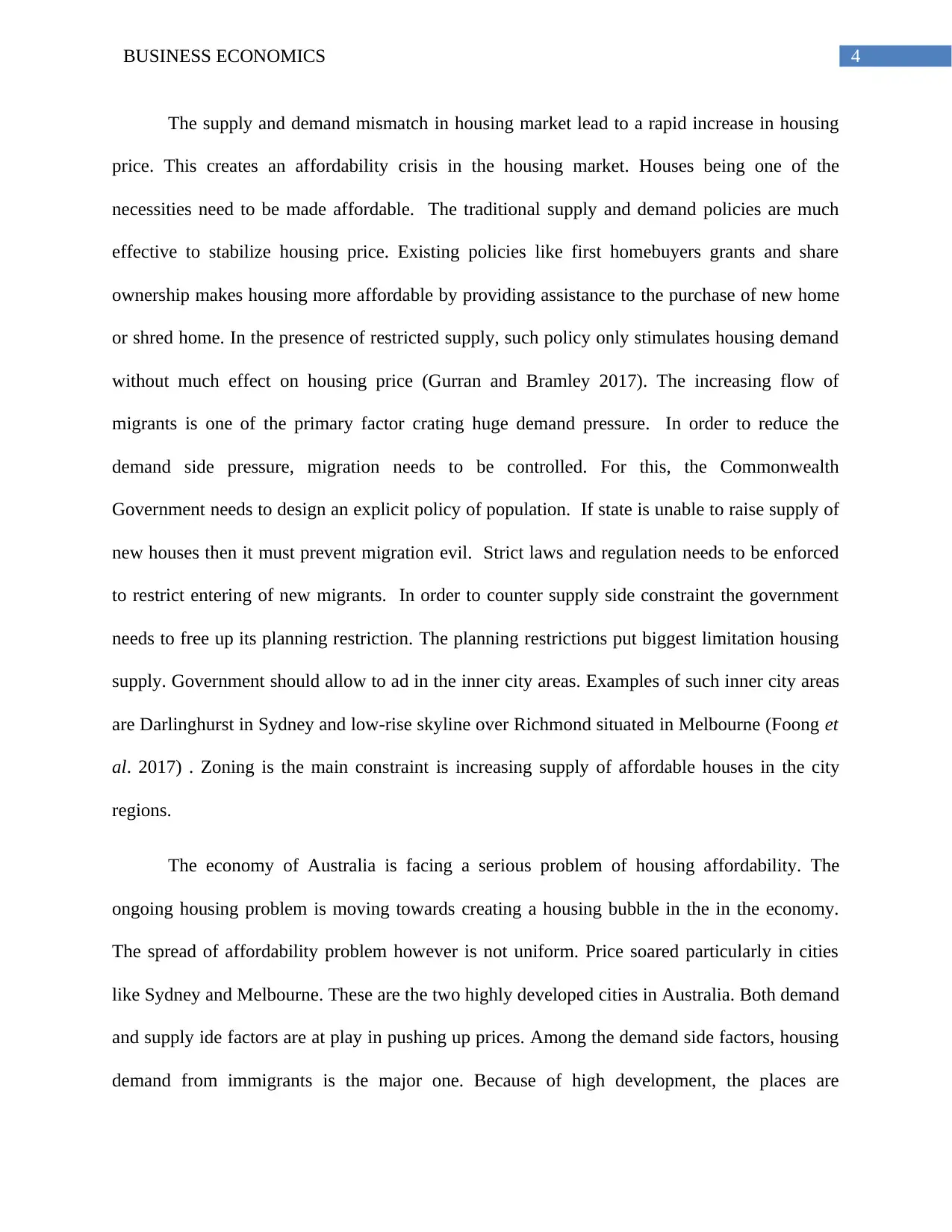
4BUSINESS ECONOMICS
The supply and demand mismatch in housing market lead to a rapid increase in housing
price. This creates an affordability crisis in the housing market. Houses being one of the
necessities need to be made affordable. The traditional supply and demand policies are much
effective to stabilize housing price. Existing policies like first homebuyers grants and share
ownership makes housing more affordable by providing assistance to the purchase of new home
or shred home. In the presence of restricted supply, such policy only stimulates housing demand
without much effect on housing price (Gurran and Bramley 2017). The increasing flow of
migrants is one of the primary factor crating huge demand pressure. In order to reduce the
demand side pressure, migration needs to be controlled. For this, the Commonwealth
Government needs to design an explicit policy of population. If state is unable to raise supply of
new houses then it must prevent migration evil. Strict laws and regulation needs to be enforced
to restrict entering of new migrants. In order to counter supply side constraint the government
needs to free up its planning restriction. The planning restrictions put biggest limitation housing
supply. Government should allow to ad in the inner city areas. Examples of such inner city areas
are Darlinghurst in Sydney and low-rise skyline over Richmond situated in Melbourne (Foong et
al. 2017) . Zoning is the main constraint is increasing supply of affordable houses in the city
regions.
The economy of Australia is facing a serious problem of housing affordability. The
ongoing housing problem is moving towards creating a housing bubble in the in the economy.
The spread of affordability problem however is not uniform. Price soared particularly in cities
like Sydney and Melbourne. These are the two highly developed cities in Australia. Both demand
and supply ide factors are at play in pushing up prices. Among the demand side factors, housing
demand from immigrants is the major one. Because of high development, the places are
The supply and demand mismatch in housing market lead to a rapid increase in housing
price. This creates an affordability crisis in the housing market. Houses being one of the
necessities need to be made affordable. The traditional supply and demand policies are much
effective to stabilize housing price. Existing policies like first homebuyers grants and share
ownership makes housing more affordable by providing assistance to the purchase of new home
or shred home. In the presence of restricted supply, such policy only stimulates housing demand
without much effect on housing price (Gurran and Bramley 2017). The increasing flow of
migrants is one of the primary factor crating huge demand pressure. In order to reduce the
demand side pressure, migration needs to be controlled. For this, the Commonwealth
Government needs to design an explicit policy of population. If state is unable to raise supply of
new houses then it must prevent migration evil. Strict laws and regulation needs to be enforced
to restrict entering of new migrants. In order to counter supply side constraint the government
needs to free up its planning restriction. The planning restrictions put biggest limitation housing
supply. Government should allow to ad in the inner city areas. Examples of such inner city areas
are Darlinghurst in Sydney and low-rise skyline over Richmond situated in Melbourne (Foong et
al. 2017) . Zoning is the main constraint is increasing supply of affordable houses in the city
regions.
The economy of Australia is facing a serious problem of housing affordability. The
ongoing housing problem is moving towards creating a housing bubble in the in the economy.
The spread of affordability problem however is not uniform. Price soared particularly in cities
like Sydney and Melbourne. These are the two highly developed cities in Australia. Both demand
and supply ide factors are at play in pushing up prices. Among the demand side factors, housing
demand from immigrants is the major one. Because of high development, the places are
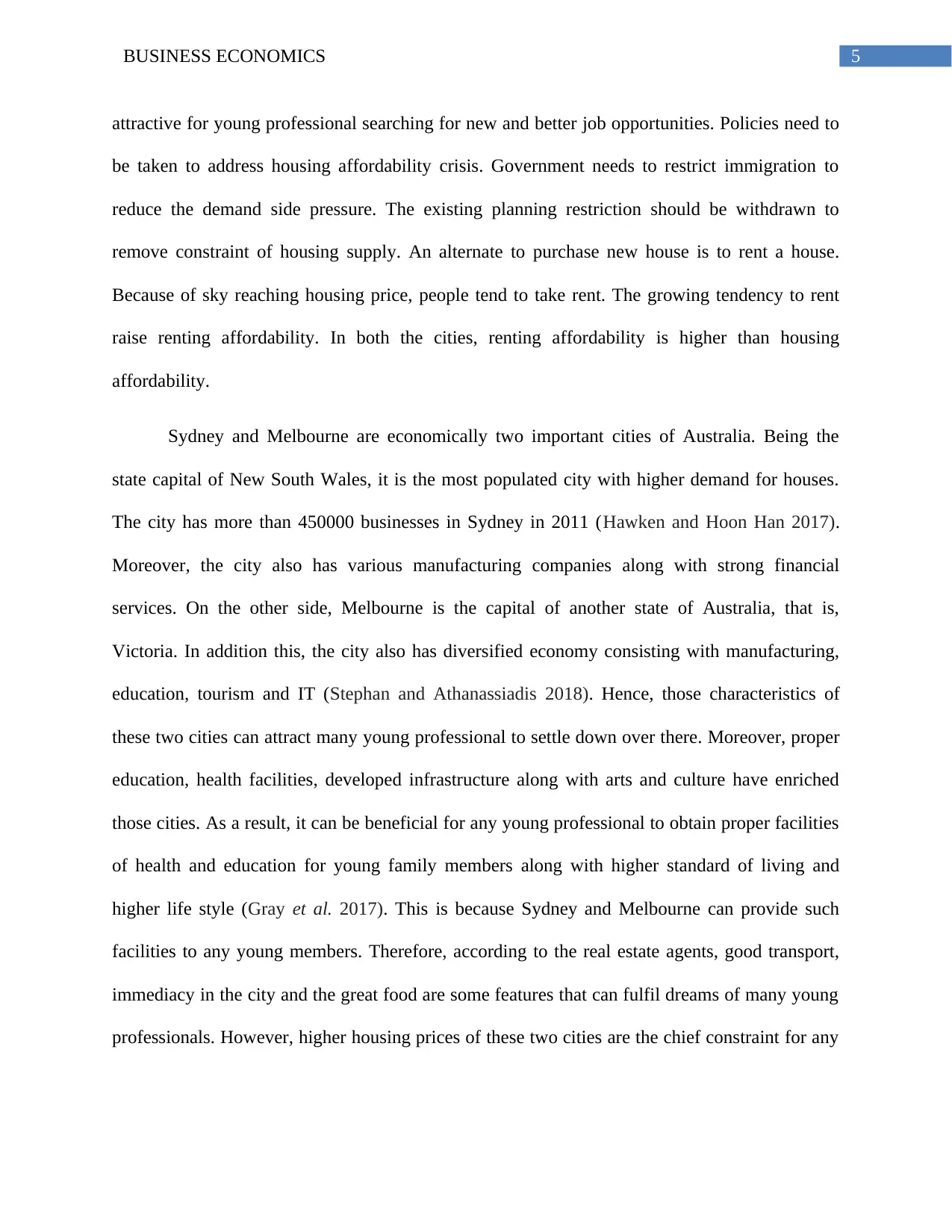
5BUSINESS ECONOMICS
attractive for young professional searching for new and better job opportunities. Policies need to
be taken to address housing affordability crisis. Government needs to restrict immigration to
reduce the demand side pressure. The existing planning restriction should be withdrawn to
remove constraint of housing supply. An alternate to purchase new house is to rent a house.
Because of sky reaching housing price, people tend to take rent. The growing tendency to rent
raise renting affordability. In both the cities, renting affordability is higher than housing
affordability.
Sydney and Melbourne are economically two important cities of Australia. Being the
state capital of New South Wales, it is the most populated city with higher demand for houses.
The city has more than 450000 businesses in Sydney in 2011 (Hawken and Hoon Han 2017).
Moreover, the city also has various manufacturing companies along with strong financial
services. On the other side, Melbourne is the capital of another state of Australia, that is,
Victoria. In addition this, the city also has diversified economy consisting with manufacturing,
education, tourism and IT (Stephan and Athanassiadis 2018). Hence, those characteristics of
these two cities can attract many young professional to settle down over there. Moreover, proper
education, health facilities, developed infrastructure along with arts and culture have enriched
those cities. As a result, it can be beneficial for any young professional to obtain proper facilities
of health and education for young family members along with higher standard of living and
higher life style (Gray et al. 2017). This is because Sydney and Melbourne can provide such
facilities to any young members. Therefore, according to the real estate agents, good transport,
immediacy in the city and the great food are some features that can fulfil dreams of many young
professionals. However, higher housing prices of these two cities are the chief constraint for any
attractive for young professional searching for new and better job opportunities. Policies need to
be taken to address housing affordability crisis. Government needs to restrict immigration to
reduce the demand side pressure. The existing planning restriction should be withdrawn to
remove constraint of housing supply. An alternate to purchase new house is to rent a house.
Because of sky reaching housing price, people tend to take rent. The growing tendency to rent
raise renting affordability. In both the cities, renting affordability is higher than housing
affordability.
Sydney and Melbourne are economically two important cities of Australia. Being the
state capital of New South Wales, it is the most populated city with higher demand for houses.
The city has more than 450000 businesses in Sydney in 2011 (Hawken and Hoon Han 2017).
Moreover, the city also has various manufacturing companies along with strong financial
services. On the other side, Melbourne is the capital of another state of Australia, that is,
Victoria. In addition this, the city also has diversified economy consisting with manufacturing,
education, tourism and IT (Stephan and Athanassiadis 2018). Hence, those characteristics of
these two cities can attract many young professional to settle down over there. Moreover, proper
education, health facilities, developed infrastructure along with arts and culture have enriched
those cities. As a result, it can be beneficial for any young professional to obtain proper facilities
of health and education for young family members along with higher standard of living and
higher life style (Gray et al. 2017). This is because Sydney and Melbourne can provide such
facilities to any young members. Therefore, according to the real estate agents, good transport,
immediacy in the city and the great food are some features that can fulfil dreams of many young
professionals. However, higher housing prices of these two cities are the chief constraint for any
⊘ This is a preview!⊘
Do you want full access?
Subscribe today to unlock all pages.

Trusted by 1+ million students worldwide
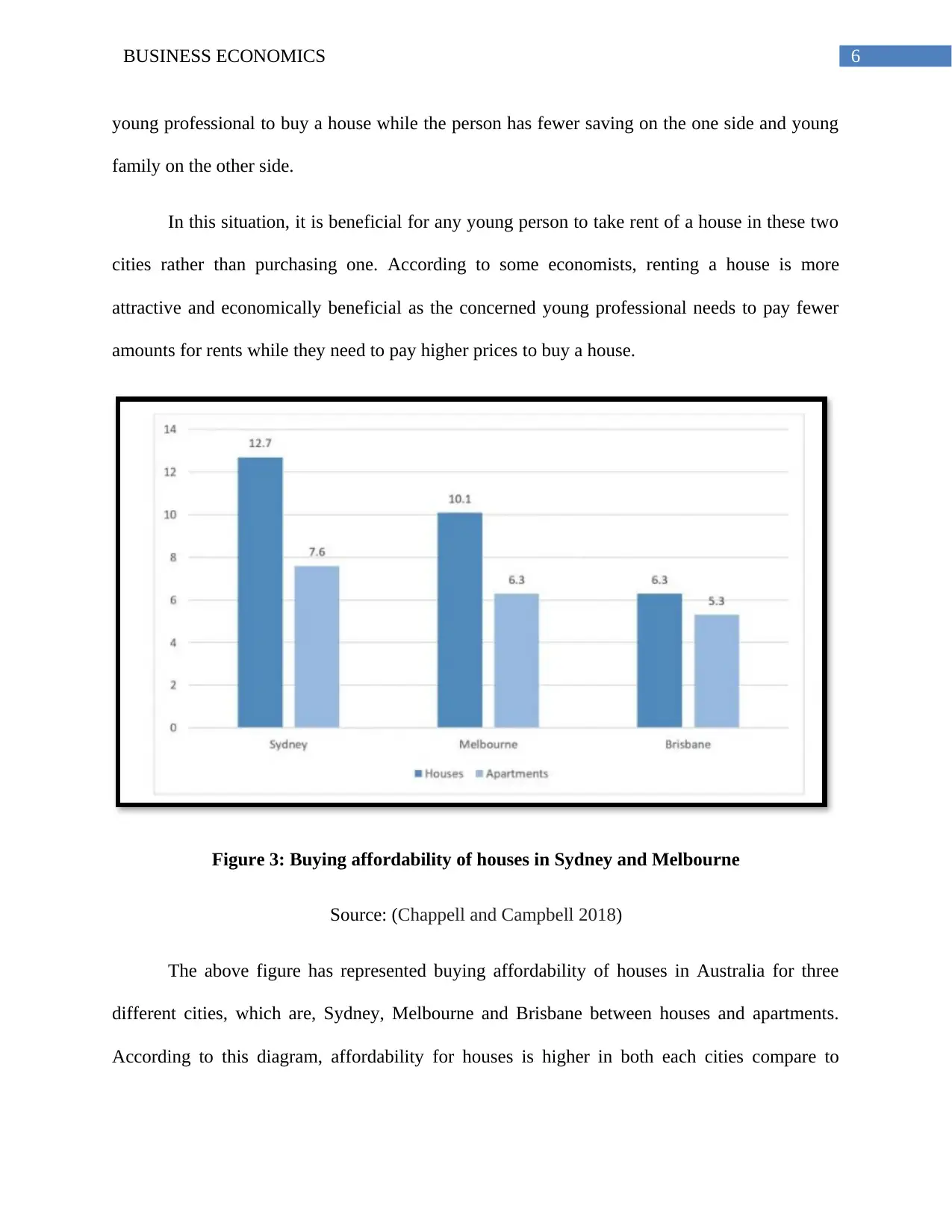
6BUSINESS ECONOMICS
young professional to buy a house while the person has fewer saving on the one side and young
family on the other side.
In this situation, it is beneficial for any young person to take rent of a house in these two
cities rather than purchasing one. According to some economists, renting a house is more
attractive and economically beneficial as the concerned young professional needs to pay fewer
amounts for rents while they need to pay higher prices to buy a house.
Figure 3: Buying affordability of houses in Sydney and Melbourne
Source: (Chappell and Campbell 2018)
The above figure has represented buying affordability of houses in Australia for three
different cities, which are, Sydney, Melbourne and Brisbane between houses and apartments.
According to this diagram, affordability for houses is higher in both each cities compare to
young professional to buy a house while the person has fewer saving on the one side and young
family on the other side.
In this situation, it is beneficial for any young person to take rent of a house in these two
cities rather than purchasing one. According to some economists, renting a house is more
attractive and economically beneficial as the concerned young professional needs to pay fewer
amounts for rents while they need to pay higher prices to buy a house.
Figure 3: Buying affordability of houses in Sydney and Melbourne
Source: (Chappell and Campbell 2018)
The above figure has represented buying affordability of houses in Australia for three
different cities, which are, Sydney, Melbourne and Brisbane between houses and apartments.
According to this diagram, affordability for houses is higher in both each cities compare to
Paraphrase This Document
Need a fresh take? Get an instant paraphrase of this document with our AI Paraphraser
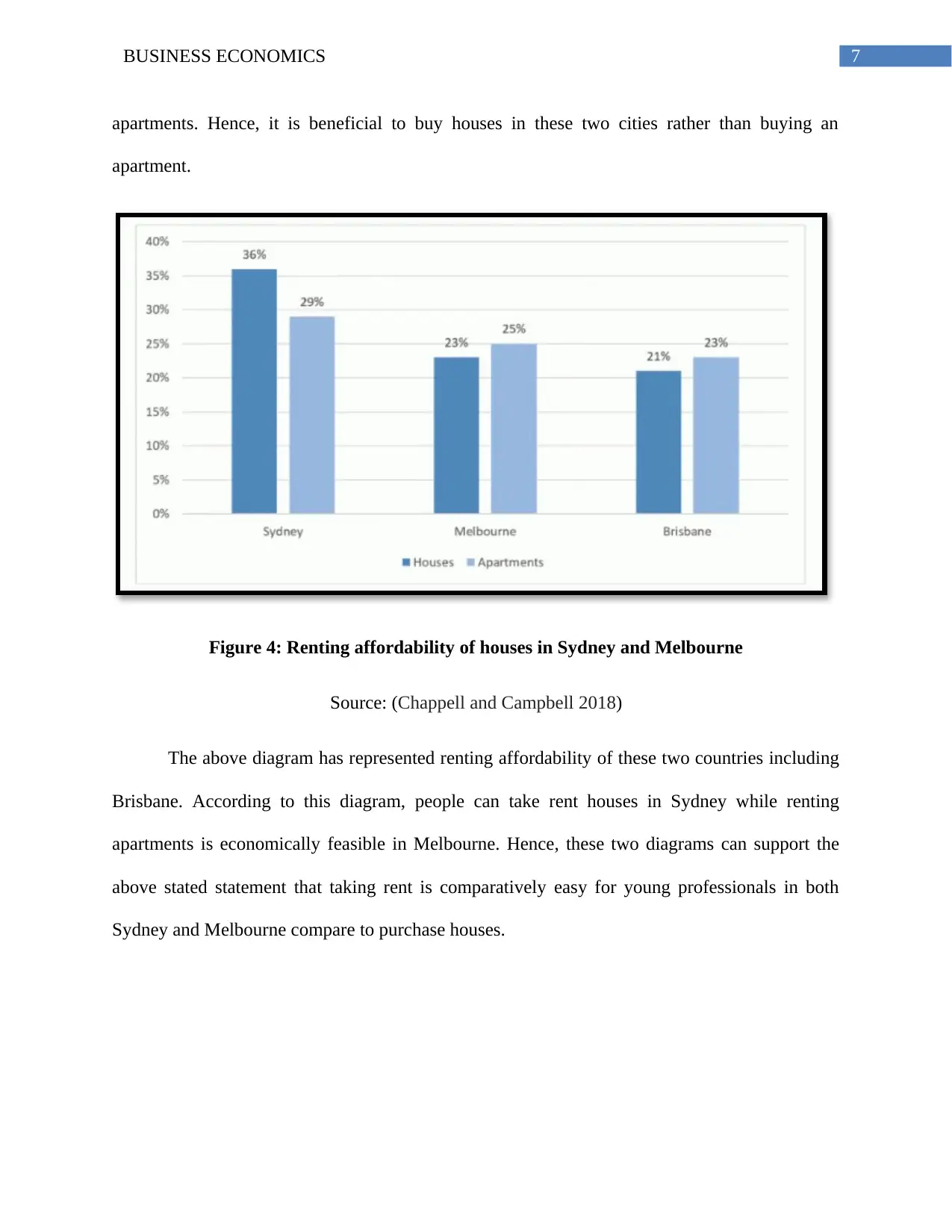
7BUSINESS ECONOMICS
apartments. Hence, it is beneficial to buy houses in these two cities rather than buying an
apartment.
Figure 4: Renting affordability of houses in Sydney and Melbourne
Source: (Chappell and Campbell 2018)
The above diagram has represented renting affordability of these two countries including
Brisbane. According to this diagram, people can take rent houses in Sydney while renting
apartments is economically feasible in Melbourne. Hence, these two diagrams can support the
above stated statement that taking rent is comparatively easy for young professionals in both
Sydney and Melbourne compare to purchase houses.
apartments. Hence, it is beneficial to buy houses in these two cities rather than buying an
apartment.
Figure 4: Renting affordability of houses in Sydney and Melbourne
Source: (Chappell and Campbell 2018)
The above diagram has represented renting affordability of these two countries including
Brisbane. According to this diagram, people can take rent houses in Sydney while renting
apartments is economically feasible in Melbourne. Hence, these two diagrams can support the
above stated statement that taking rent is comparatively easy for young professionals in both
Sydney and Melbourne compare to purchase houses.
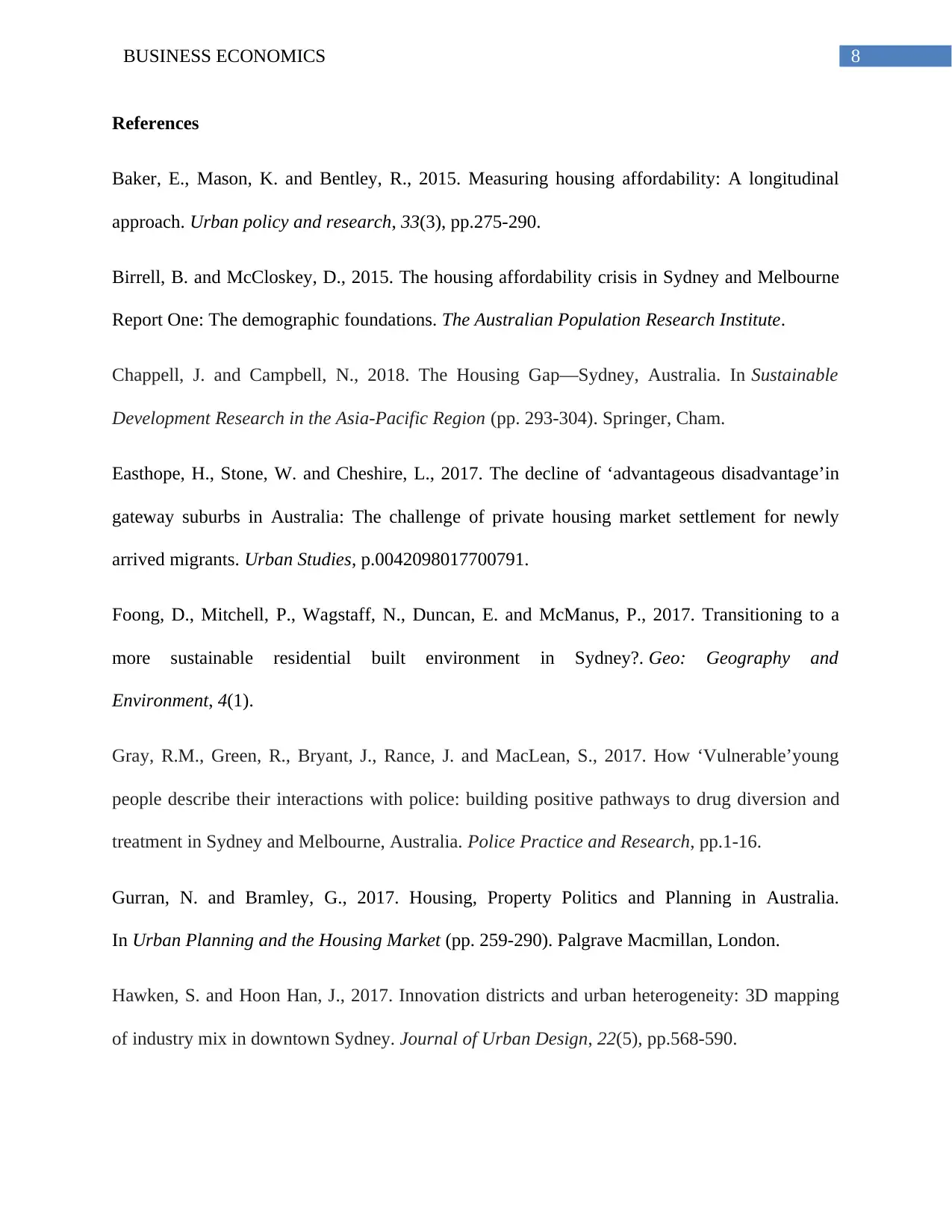
8BUSINESS ECONOMICS
References
Baker, E., Mason, K. and Bentley, R., 2015. Measuring housing affordability: A longitudinal
approach. Urban policy and research, 33(3), pp.275-290.
Birrell, B. and McCloskey, D., 2015. The housing affordability crisis in Sydney and Melbourne
Report One: The demographic foundations. The Australian Population Research Institute.
Chappell, J. and Campbell, N., 2018. The Housing Gap—Sydney, Australia. In Sustainable
Development Research in the Asia-Pacific Region (pp. 293-304). Springer, Cham.
Easthope, H., Stone, W. and Cheshire, L., 2017. The decline of ‘advantageous disadvantage’in
gateway suburbs in Australia: The challenge of private housing market settlement for newly
arrived migrants. Urban Studies, p.0042098017700791.
Foong, D., Mitchell, P., Wagstaff, N., Duncan, E. and McManus, P., 2017. Transitioning to a
more sustainable residential built environment in Sydney?. Geo: Geography and
Environment, 4(1).
Gray, R.M., Green, R., Bryant, J., Rance, J. and MacLean, S., 2017. How ‘Vulnerable’young
people describe their interactions with police: building positive pathways to drug diversion and
treatment in Sydney and Melbourne, Australia. Police Practice and Research, pp.1-16.
Gurran, N. and Bramley, G., 2017. Housing, Property Politics and Planning in Australia.
In Urban Planning and the Housing Market (pp. 259-290). Palgrave Macmillan, London.
Hawken, S. and Hoon Han, J., 2017. Innovation districts and urban heterogeneity: 3D mapping
of industry mix in downtown Sydney. Journal of Urban Design, 22(5), pp.568-590.
References
Baker, E., Mason, K. and Bentley, R., 2015. Measuring housing affordability: A longitudinal
approach. Urban policy and research, 33(3), pp.275-290.
Birrell, B. and McCloskey, D., 2015. The housing affordability crisis in Sydney and Melbourne
Report One: The demographic foundations. The Australian Population Research Institute.
Chappell, J. and Campbell, N., 2018. The Housing Gap—Sydney, Australia. In Sustainable
Development Research in the Asia-Pacific Region (pp. 293-304). Springer, Cham.
Easthope, H., Stone, W. and Cheshire, L., 2017. The decline of ‘advantageous disadvantage’in
gateway suburbs in Australia: The challenge of private housing market settlement for newly
arrived migrants. Urban Studies, p.0042098017700791.
Foong, D., Mitchell, P., Wagstaff, N., Duncan, E. and McManus, P., 2017. Transitioning to a
more sustainable residential built environment in Sydney?. Geo: Geography and
Environment, 4(1).
Gray, R.M., Green, R., Bryant, J., Rance, J. and MacLean, S., 2017. How ‘Vulnerable’young
people describe their interactions with police: building positive pathways to drug diversion and
treatment in Sydney and Melbourne, Australia. Police Practice and Research, pp.1-16.
Gurran, N. and Bramley, G., 2017. Housing, Property Politics and Planning in Australia.
In Urban Planning and the Housing Market (pp. 259-290). Palgrave Macmillan, London.
Hawken, S. and Hoon Han, J., 2017. Innovation districts and urban heterogeneity: 3D mapping
of industry mix in downtown Sydney. Journal of Urban Design, 22(5), pp.568-590.
⊘ This is a preview!⊘
Do you want full access?
Subscribe today to unlock all pages.

Trusted by 1+ million students worldwide
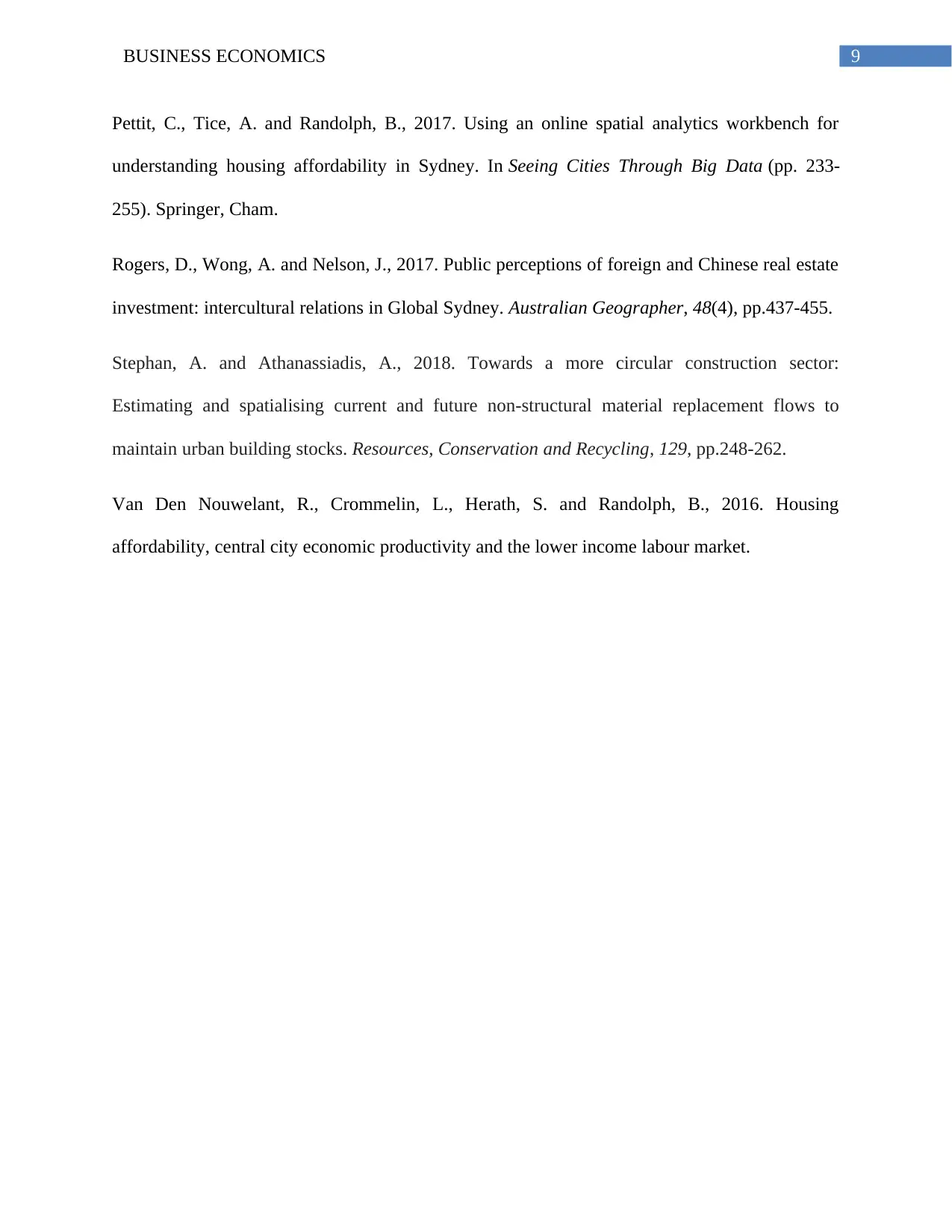
9BUSINESS ECONOMICS
Pettit, C., Tice, A. and Randolph, B., 2017. Using an online spatial analytics workbench for
understanding housing affordability in Sydney. In Seeing Cities Through Big Data (pp. 233-
255). Springer, Cham.
Rogers, D., Wong, A. and Nelson, J., 2017. Public perceptions of foreign and Chinese real estate
investment: intercultural relations in Global Sydney. Australian Geographer, 48(4), pp.437-455.
Stephan, A. and Athanassiadis, A., 2018. Towards a more circular construction sector:
Estimating and spatialising current and future non-structural material replacement flows to
maintain urban building stocks. Resources, Conservation and Recycling, 129, pp.248-262.
Van Den Nouwelant, R., Crommelin, L., Herath, S. and Randolph, B., 2016. Housing
affordability, central city economic productivity and the lower income labour market.
Pettit, C., Tice, A. and Randolph, B., 2017. Using an online spatial analytics workbench for
understanding housing affordability in Sydney. In Seeing Cities Through Big Data (pp. 233-
255). Springer, Cham.
Rogers, D., Wong, A. and Nelson, J., 2017. Public perceptions of foreign and Chinese real estate
investment: intercultural relations in Global Sydney. Australian Geographer, 48(4), pp.437-455.
Stephan, A. and Athanassiadis, A., 2018. Towards a more circular construction sector:
Estimating and spatialising current and future non-structural material replacement flows to
maintain urban building stocks. Resources, Conservation and Recycling, 129, pp.248-262.
Van Den Nouwelant, R., Crommelin, L., Herath, S. and Randolph, B., 2016. Housing
affordability, central city economic productivity and the lower income labour market.
1 out of 10
Related Documents
Your All-in-One AI-Powered Toolkit for Academic Success.
+13062052269
info@desklib.com
Available 24*7 on WhatsApp / Email
![[object Object]](/_next/static/media/star-bottom.7253800d.svg)
Unlock your academic potential
Copyright © 2020–2025 A2Z Services. All Rights Reserved. Developed and managed by ZUCOL.




